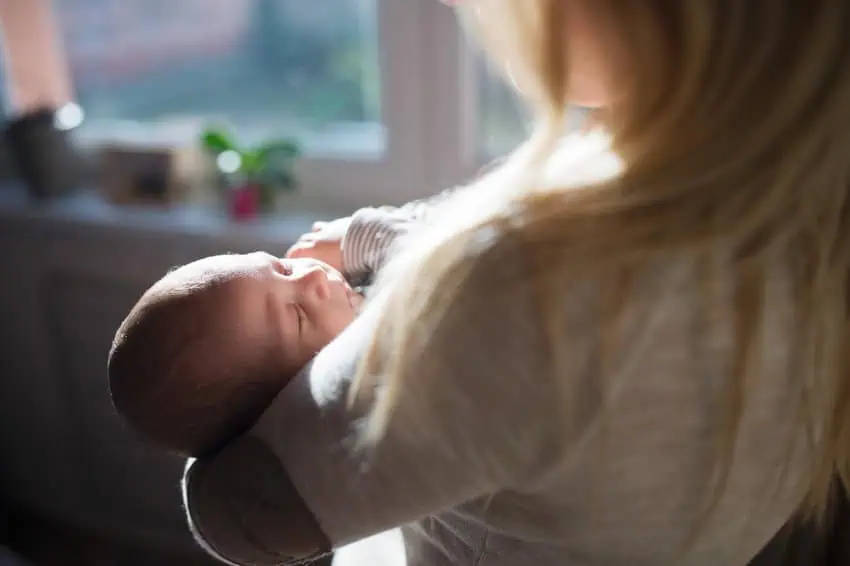At 12 weeks, my daughter began sleeping through the night on her own but her twin brother was holding out on us.
My husband and I poured through the stack of baby books we had sitting on our nightstands and practiced these same sleeping habits I’m going to share with you, which helped him learn to sleep through the night on his own at four months old.
During the first two months of your newborn’s life, her need to eat overrides her need to sleep, especially to sleep through the night. Eating every two hours and cluster feeding for days on end may leave you feeling sleep deprived enough to make you cry into your third cup of coffee, but hang in there.
There is a light to the sleepless nights.
If you’re ready to jump ahead, I put all my routines (40 of them) and tips for excellent sleep in Mastering Sleep & Schedules which can you get instant access to.
But first, let’s dive into what’s going on with your baby and what are some signs they might be ready to start the momentous journey of sleeping through the night.
Your Baby’s Physical & Cognitive Development
Newborns need 16 or more hours of sleep each day (see the recommended sleep guidelines), but often these stretches of sleep are doled out in chunks of 2-4 hour periods of time, instead of a full night’s rest which is what every sleep deprived parent is hoping for.
The pattern of sleep is erratic at first because of your baby’s rapid growth and insatiable need to eat, and these override any form of a sleep schedule. Over time as your baby can go longer stretches between feedings, sleep patterns will begin to emerge.
Your baby is close to sleeping through the night when:
- She increases her feeding amounts and gains weight – both necessary to sleep for long periods of time.
- Naturally cuts out a feeding or two during the night in favor of sleep.
- Can self-soothe (pacifier, sucking on fingers or hand) and get back to sleep if she wakes up in the night or early from a nap.
- Moro reflex decreases. This is the startle reflect which causes your baby’s limps to jerk in response to environmental triggers like loud noise, a dream or sudden movements. Using a swaddle can help with the startle reflex, keeping her arms from flailing and waking her up, however the Moro reflex usually disappear by the age of 4 months.
Here are the keys to help your baby sleep through the night when they show physical & cognitive signs they’re ready.
1. Create a Peaceful Bedtime Routine
After the chaos of the newborn stage wears off and you feel like you’re getting better at reading your baby and her cues, around 6 to 8 weeks you can begin to implement a bedtime routine.
A study of 405 mothers with children between 7 and 3 years old, found that babies who adhered to a nightly bedtime routine settled to sleep easier, were overall better sleepers even in later years, and woke up less and cried out less often in the middle of the night than children who didn’t follow a nightly bedtime rhythm.
Establishing a peaceful bedtime routine can be the key to helping your baby learn to go to sleep on her own, and is the foundation for positive sleep habits which will follow her throughout childhood.
Read about how to create a peaceful bedtime routine for your baby, and what a calm nightly routine looks like.
The key to bedtime is to have a calming environment without overstimulation. A warm bath, nursing or bottle feeding in the nursery, softly lit room, use of a sound machine, rocking, cuddling and a soft lullaby will all help to create a peaceful and successful bedtime.
2. Work on Building a Routine During the Day
The success of a nightly bedtime routine will hinge on how well you maintain a daily routine during the daytime hours as well. Children feel secure and safe with the predictability of a routine, especially little ones, begin to understand what comes next.
Of course, as your baby’s sleep needs change and they’re able to stay awake for longer periods of time, your routine will shift every few weeks to months.
The Printable Sample Schedules & Routine eBook has sample routines for every age from newborn through preschool age to help you adjust based on your baby’s growth, sleep and developmental needs.
Download Your Routine Tracker – The Starting Place for Creating a Better Routine and Great Sleep Habits
3. Put Your Baby to Sleep at the Right Bedtime
Putting a baby to bed when they’re overtired always results in extra fussy behavior, increase in crying and trouble falling to asleep. No other that, a baby who is put to bed past their bedtime will have sleep problems throughout the night such as night waking and trouble self-soothing.
See the recommended sleep guidelines to help you set a bedtime based on your baby’s age, and suggested hours of sleep and awake time spread between nap and bedtime.
Read your baby’s cues, when she begins to fussy, becomes more irritable or rubs her eyes, start your bedtime routine.
All three of my children until the age of 1 ½ used to go to bed at 6:30pm and while our family thought this was much too early, this was the right time for them to peacefully settle to sleep, instead of fighting off bedtime for another hour or longer!
4. Help Your Baby Sort Out the Difference Between Day & Night
Babies may sleep anywhere from 12 – 18 hours during the day depending on their age, and often can go for long stretches of sleeping (3 to 4 hours) at a time. What you commonly see is a baby who sleeps well during the day and gets their long stretches of rest in during the morning or afternoon, and then wants to stay awake all night long.
For example, your baby is awake from 2am – 5am and then sleeps great during the day from 9am – 12pm and 2pm.
The problem? Your baby is confusing daytime with nighttime and it’s up to you to help them naturally get their days straight.
During the day, open the windows, pull up the blinds and get outside whenever possible. Exposure to natural light will help your baby’s body naturally adjust to daytime versus nighttime when it’s dark and quiet. This plays a big role in them learning to sleep for longer periods at night instead of during the daytime.
5. Put Your Baby to Bed Drowsy, Not Already Asleep
As you create a solid bedtime routine for your baby around 6 – 8 weeks old, it’s important to put her to bed drowsy, not asleep. When your baby is on the verge of falling asleep and is still slightly awake, gently place her in her crib so she can learn to drift off to sleep on her own.
If you consistently put your baby to bed when she’s asleep, whether it’s after a feeding or rocking her to sleep, this creates the habit of a sleep association. This means, she will become accustomed to needing assistance to go to bed every night, which in the long run, is a bad habit that’ll be harder to break later in her life.
If your child is dependent on you to fall asleep, she’ll also be dependent on you to fall back asleep when she wakes in the middle of the night.
The more consistently you put your baby to sleep drowsy, the better she’ll get at doing it for herself.
6. Make Room Environment Conducive for Sleep
Making your baby’s room as sleep friendly and cozy as possible, will help her feel comfortable and secure being by herself and drifting to sleep.
A couple key elements to a cozy bedroom to promote restful sleep:
- Dark Room & lights on dimmers (blackout curtains are a lifesaver with kids!)
- Use a sound machine or fan to replicate the noise your baby was surrounded with in the womb and this will help her fall to sleep, and then fall back asleep if she wakes up. White noise is helpful to block out startling noises which can wake them up like the doorbell, a barking dog, dropped dish in the kitchen, siblings, etc.
- Swaddles to help with the Moro Reflex and control flailing arms & legs which can both wake up your baby. These are my top recommended swaddles that work well, but aren’t too snug or confining:
- Love to Dream Swaddle Newborn – Small
- Love to Dream Swaddle Medium with Arms That Can Unzip & Turn Into a Sleep Sack
- Baby Needle Sleep Sack for Cold Nights to Keep Your Baby Warm!
- Use a pacifier to help teach your baby how to self-soothe and put herself back to sleep.
- Check the room’s temperature – a cooler room has been studied to help little ones sleep better. A room that’s too warm can cause your baby to wake up and overheating is extremely dangerous. This room temperature monitor will keep track of whatever room it’s placed it – great in just the baby’s room.
7. Wait a Minute Before You Comfort Your Baby
If your baby cries at night, wait a moment before you go in to check on her. Your baby just might be able – and ready – to self soothe and get herself back to sleep without your help.
The amount of time you wait to go into her room depends on you and your baby, but you can start with one minute and increase up to 5 minutes depending on your baby’s age and your level of comfort
Start by waiting for one minute, and then go in and gently soothe your baby. Try not to make eye contact or turn on the lights and wake her up further with too much stimulation.
If she cries again after you leave the room, wait two minutes this time and then go in and soothe your baby.
Add one minute for each time you go in, but if there is a point where you can tell your baby is not going to stop and needs you, save the waiting for another night and give it another try then.
If you choose to stick with this method, know it could take a few nights before you see progress, but being consistent is key.
Sleepless nights are a rite of passage for parents and they will come to an end. You can help lead your baby to sleeping through the night by giving her the best sleep environment, a solid daily and bedtime routine, and giving her the tools to fall asleep, and back to sleep, on her own. In the meantime, as you push through this sleep journey, have patience and know these nights will not last forever. Changes aren’t generally immediate, but take time and consistency.
Additional Reading on This Topic
- Expert Tips to Surviving the 8 Month Sleep Regression
- Signs It’s Time to Move to One Nap a Day: How to Master the Nap Transition
- Scared of the Dark: How to Conquer Nighttime Fears
- Making the Transition to a Big Kid Bed
- 8 Common Toddler Sleep Problems & How to Handle Them
- 7 Ways to Beat Bedtime Stalling with Young Kids
- Is Your Kid Waking Up Too Early? How to Fix It
- 10 Helpful Ways to Calm the Kid Who Fights Bedtime
- Toddler Sleep Regressions: What You Need to Know About Your Two Year Old’s Sleep
- How to Establish a Peaceful Bedtime Routine for Your Baby
Want even more?
Shop All Parenting Resources
Shop all of our parenting resources from self-regulation tools and managing big emotions to building self esteem and confidence. There are resources for all seasons of life!








